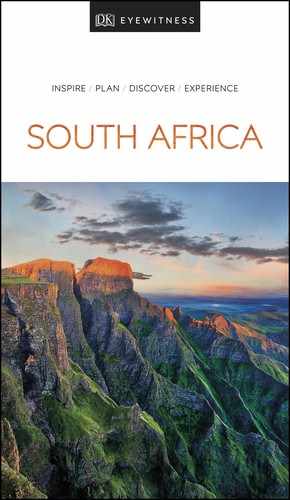g Eastern Cape g Contents
Experience More

t Turquoise waves breaking against the rocky coastline of Port Elizabeth
Facing east towards the wide sweep of Algoa Bay, South Africa’s third-largest port was established in 1820 by Sir Rufane Donkin (then acting Governor of the Cape) and is named after his late wife, Elizabeth. It was the landing point for the 1820 Settlers, 4,000 British economic refugees shipped here to bolster the colony’s English-speaking population and protect its vulnerable eastern border against the neighbouring Xhosa. Ironically, this former bastion of British settler culture today forms the centrepiece of a municipality named after that most celebrated of Xhosa leaders – Nelson Mandela Bay.
Often referred to as the Friendly City, Port Elizabeth is lined with wide beaches and well-preserved historic buildings. Donkin Reserve is a central park that includes the Donkin Lighthouse. Built in 1861, it is now a tourism office, as well as the country’s tallest flagpole and a memorial to Elizabeth Donkin. The adjacent Port Elizabeth Opera House, the oldest in the southern hemisphere, was built in 1862 on a site once used for public hangings; its two stages still host many plays and shows.
Most safely explored with a local guide, lovely St George’s Park is home to South Africa’s oldest cricket ground and a collection of exotic plants, housed in the 19th-century Pearson Conservatory. Further south, the Boardwalk is a slick seafront complex that hosts numerous restaurants and bars, as well as entertainment venues such as an open-air theatre and a 24-hour casino. Near the harbour is Fort Frederick, named after the Duke of York and built in 1799 to prevent an invasion by French supporters of the rebel republic of Graaff-Reinet. Although defended by eight cannons, no salvoes were ever fired in an act of war. The arrival of the 1820 Settlers was overseen by the fort’s commander, Captain Francis Evatt, whose grave can be seen here.
Just along the coast is Humewood Beach, a popular recreation hub that provides quick access to all the seaside attractions. A covered promenade provides shelter from the wind and hosts a weekend flea market. There is a freshwater and tidal pool complex in addition to the main beaches, and sailing and scuba diving are very popular.
The beach is also home to Bayworld, an unusual combination of museum, aquarium and snake park. The museum includes a gallery of salvaged items and an exhibition featuring original artifacts of the Khoi, the area’s earliest known inhabitants. On view at the snake park are the likes of puff adder and green mamba, while the aquarium’s observation windows allow visitors to view penguins swimming underwater.
Further south, at the entrance to Algoa Bay, the Cape Recife Conservancy can be explored along a hiking trail that traverses unspoiled rocky shores and dune vegetation, and passes the 1850 Cape Recife Lighthouse. Nearby, the South African Foundation for the Conservation of Coastal Birds centre rescues marine birds, especially penguins. Visitors can tour the premises and watch the penguins being fed at 2:30pm daily.

t Port Elizabeth’s palm-lined Boardwalk, which is dotted with restaurants and entertainment venues
Fort Frederick
⌂ Belmont Terrace # Sunrise–sunset daily
Bayworld
⌂ Beach Rd # 9am–4:30pm daily ∑ bayworld.co.za
Cape Recife Conservancy
⌂ 13 km (8 miles) S of Port Elizabeth # Sunrise–sunset daily ∑ caperecife.co.za
EXPERIENCE Eastern Cape
EARLY SETTLER ARCHITECTURE

t A memorial that stands outside the city’s Donkin Reserve
Port Elizabeth is studded with buildings associated with the 1820 Settlers. No 7 Castle Hill, a settler’s cottage from 1827, is now a museum, while the quaint double-storey 19th-century houses along Donkin Street are a national monument. Overlooking them all is the Campanile, a 52-m- (170-ft-) tall tower built in 1923 to commemorate the settlers’ arrival, which has a lofty viewing platform reached via a spiral staircase.
EXPERIENCE Eastern Cape
|
eat & stay Royal Delhi This family-run Indian restaurant is an unpretentious, good-value favourite. The deboned lamb curry is delicious, and there’s an excellent vegetarian selection too. ⌂ 10 Burgess St, Port Elizabeth ¢ Sun ∑ royaldelhi.co.za Natti’s Thai Kitchen An informal eatery that’s been serving up authentic Thai dishes since 1997 – try the searingly hot “angry duck”. ⌂ 5 Park Lane, Port Elizabeth § 041 373 2763 ¢ Mon & Sun The Boardwalk This five-star hotel is attached to the entertainment complex, offering easy access to both the beach and boutiques. ⌂ Beach Rd, Summer Strand, Port Elizabeth ∑ suninternational.com/boardwalk Brighton Lodge A small guesthouse with luxury suites, a swimming pool and a good range of other amenities. ⌂ 21 Brighton Dr, Summer Strand, Port Elizabeth ∑ brightonlodge.co.za |
This once sleepy seaside town, reputedly named after the whaler Captain Jeffreys and referred to as “J-Bay” by locals, is now the centre of South Africa’s surfer scene. It is often ranked among the world’s top 10 surfing spots, with a tubing right-hand break that offers a ride of over 1 km (0.5 miles) in the right conditions. The town is busiest in early July, when the World Surf League (WSL) holds its only African championship tour event there.
Jeffreys Bay’s blue flag beach is perfect for swimming and sunbathing, while the Jeffreys Bay Shell Museum is the finest collection of its kind in the country. Established in 1945 by Charlotte Kritzinger, a local resident who first began collecting shells in her own home, the museum now showcases more than 600 different types of shell from all around the world.
Jeffreys Bay Shell Museum
⌂ Da Gama Rd § 082 852 4056 # 10am–3pm Mon–Fri
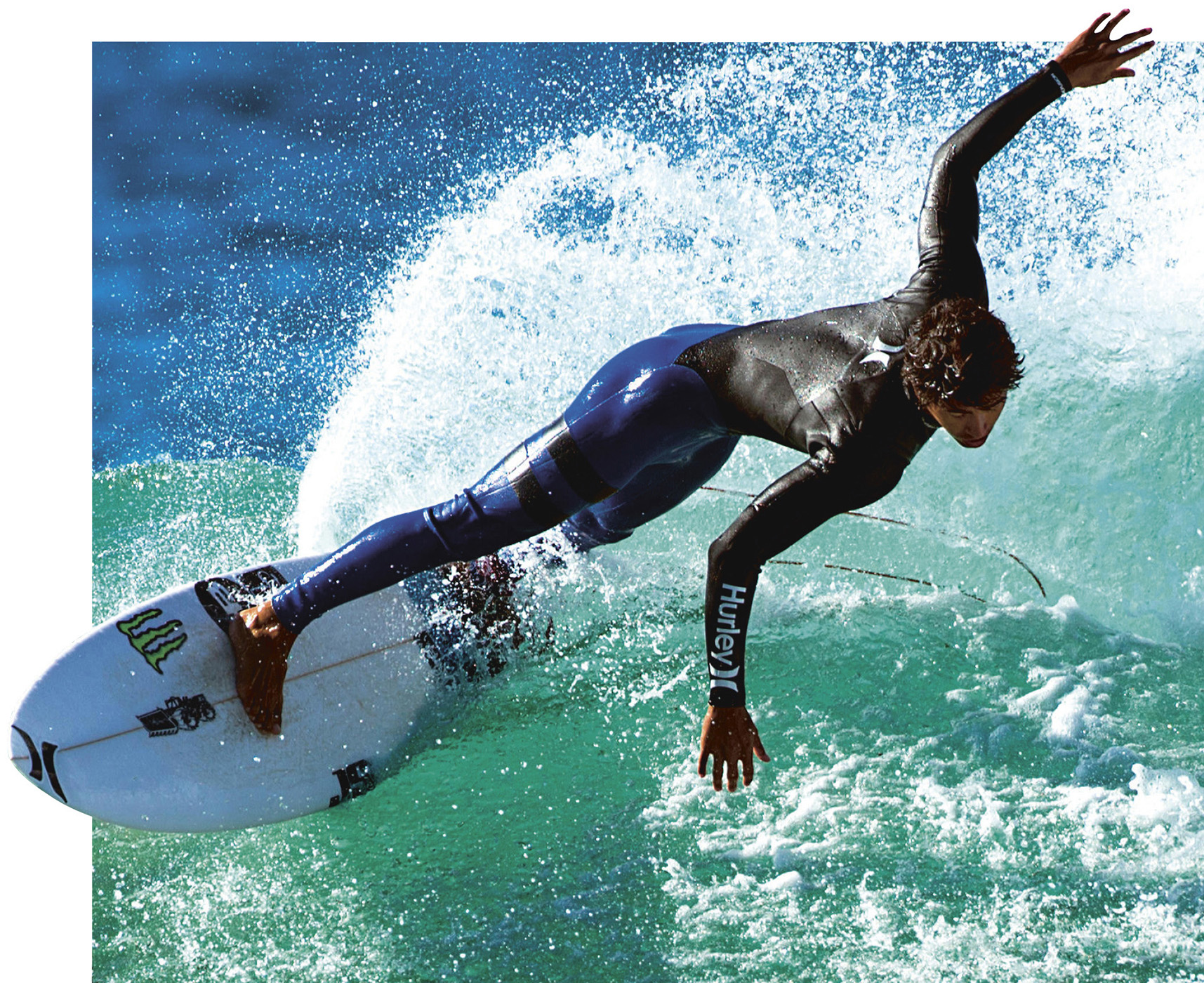
t A local surfer taking advantage of the legendary waves in Jeffreys Bay
EXPERIENCE Eastern Cape
Coelacanth

In 1938, a boat fishing off the Chalumna River mouth netted an unusual fish. The captain sent it to the East London Museum, whose curator, Marjorie Courtenay-Latimer, contacted Professor JLB Smith, ichthyologist at Rhodes University. The fish – distinguished by its six primitive, limb-like fins – belonged to a species believed to have become extinct with the dinosaurs. The reward offered for another coelacanth, as the fish was named, was claimed only in 1952.
Port Alfred, an upmarket seaside resort in the Eastern Cape, is well known for its superb beaches. Those west of the river mouth are more developed; those to the east are unspoiled and excellent for long walks. Kelly’s Beach offers safe bathing, while the entire stretch of coast is perfect for surfing and is also popular with rock and surf fishermen.
Nearby, the Kowie Nature Reserve has an 8-km (5-mile) hiking trail with various exit points for those wanting shorter walks. It passes through a thickly forested canyon, with picnic sites next to the river.
"
Kowie Nature Reserve
⌂ R67, 5 km (3 miles) N of Port Alfred # 7am–7pm daily
After the Fifth Frontier War of 1819, the land between the Great Fish and Keiskamma rivers was declared neutral territory, and British settlers were brought in to act as a buffer against the Xhosa incursions. Today this area forms the Great Fish River Nature Reserve, where the semiarid bushveld vegetation sustains large populations of plains game, including blue wildebeest, waterbuck and giraffe, as well as buffalo, elephant and hippo. There are tracks suitable for cars along the two rivers, and the area is also suitable for hiking.
East London was originally founded as a military camp on the banks of the Buffalo River in 1847, and its strategic position as a river port was soon recognized. Originally known as Port Rex, East London was accorded city status in 1914, and today is the second-largest city in the Eastern Cape. It is predominantly an industrial centre, dominated by a Daimler Chrysler plant that manufactures vehicles for both domestic use and export.
East London is known for its safe swimming beaches, which are washed by the warm waters of the Indian Ocean. The East London Museum has an interesting collection of ethnographic and natural history exhibits. The latter includes the only surviving dodo egg, and the the first live coelacanth specimen (see box). In front of the City Hall is a statue of Steve Biko, the iconic Black Consciousness Movement leader who was detained without trial and beaten to death by security police in 1977. It was unveiled 20 years later by Nelson Mandela.
"
East London Museum
⌂ 319 Oxford St # 9am–4:30pm Mon–Thu, 9am–4pm Fri, 9am–1pm Sat ∑ elmuseum.za.org
This picturesque seaside town is known for its superb surfing, though it lacks the trendy scene associated with neighbouring Jeffreys Bay. It is also very popular with hikers and nature lovers thanks to the five nature reserves and abundant walking trails in the area. The pick among these is the Cape St Francis Nature Reserve, which protects a rocky headland and unspoiled coastline immediately south of town. Bottlenose dolphins and, from August to December, southern right whales, are often spotted offshore, while Cape grysbok, yellow mongoose and African penguin inhabit dry land.
Since 1878, the Cape has been guarded by the Seal Point Lighthouse, which houses a small museum and offers fantastic views of the bay.
Cape St Francis Nature Reserve
⌂ Cape St Francis ∑ capestfrancis.co.za

t Seal Point Lighthouse, which guards St Francis Bay
EXPERIENCE Eastern Cape
|
stay Shaloha Guesthouse A luxury guesthouse, ideally positioned for taking in golden sunrises and the world-famous surfing break. ⌂ 31 Flame Crescent, Jeffreys Bay ∑ shalohaguesthouse.com Halyards Hotel & Spa Family-friendly hotel at the Royal Alfred Marina. Activities include river cruises. ⌂ Albany Rd, Port Alfred ∑ riverhotels.co.za Quarry Lake Inn This four-star guesthouse overlooks a rehabilitated quarry, which has a small lake and plentiful birdlife. ⌂ Quarzite Dr, East London ∑ quarrylakeinn.co.za |

t Grahamstown’s attractive, pastel-coloured buildings
After the Fourth Frontier War of 1812, Colonel John Graham established a military post on an abandoned farm near the southeast coast. In an attempt to stabilize the region, the Cape government enticed 4,500 British families to the farmlands. Many of these “1820 Settlers” preferred an urban life, and Grahamstown became a thriving trading centre, home to the largest concentration of artisans outside Cape Town.
Today Grahamstown is known for its 50 plus churches, university and superb schools. Its major attractions lie close to the City Hall in High Street. Some 60 buildings have been declared national monuments, and a host of well-restored Georgian and Victorian residences line the streets. Owned by Rhodes University, the Albany Museum Complex incorporates seven separate venues. Two of them, the History and Natural Sciences museums, display fossils, settler artifacts and Xhosa dress. Another, the Old Provost, was built in 1838 as a military prison. Drostdy Gateway, which frames the university entrance, is all that remains of the 1842 magistrate’s offices. Fort Selwyn was built in 1836 and was used as an artillery barracks.
Also part of the Albany Museum Complex, but located on a different site, is the Observatory Museum. This is the historic home and workshop of a mid-19th-century Grahamstown jeweller. It has a Victorian camera obscura in the turret, which projects images of the town onto a wall.
In addition to the Albany museums, the beautiful old campus of Rhodes University houses the world-famous South African Institute for Aquatic Biodiversity, where the most interesting displays are two rare embalmed coelacanths. This prehistoric deep-water fish was presumed extinct until its “discovery” in East London in 1939. There is also a collection of other marine and freshwater fish. Visitors interested in traditional African music should also call in to the university’s International Library of African Music. Multientry tickets are available for purchase.
Adjoining the university are the Makana Botanical Gardens. Reminiscent of an English park, they were laid out in 1853 and are a national monument. Indigenous plants including aloes, cycads and proteas attract more than 100 species of garden birds.
The town’s most prominent landmark is the Cathedral of St Michael and St George, which stands out with its towering 51-m (166-ft) spire. The original St George’s Church, built in 1824, is the oldest Anglican Church in South Africa, and the organ is one of the country’s finest.
Not far from the cathedral is the National English Literary Museum. It began life as a small personal collection of indigenous manuscripts, which grew until it was declared a cultural institution in 1980. Preserved here are documents, early manuscripts and personal letters relating to South Africa’s most important writers. Entrance to the museum is free, although donations are welcomed.
Reminiscent of an old fort, the 1820s Settlers Monument on Gunfire Hill was built in 1974 in the shape of a ship, and commemorates the British families who arrived in the area in 1820. The modern Monument Theatre complex nearby is the main venue for the annual 11-day National Arts Festival. Many paintings decorate the impressive foyer.
Albany Museum Complex
⌂ Various venues ∑ am.org.za
"
Observatory Museum
⌂ Bathurst Street § 046 622 2312 # 9am–5pm Mon–Fri
"
Rhodes University
⌂ Artillery Road ∑ ru.ac.za
South African Institute for Aquatic Biodiversity
⌂ Somerset St # 8am–4pm Mon–Fri ¢ Good Fri, 25 Dec ∑ saiab.ac.za
International Library of African Music
⌂ Off Prince Alfred Street # By appt ∑ ru.ac.za/ilam
Makana Botanical Gardens
⌂ Lucas Ave § 046 603 8240 # 8am–4:30pm daily
Cathedral of St Michael and St George
⌂ High St # 9am–3pm Mon–Fri, 9am–noon Sat ∑ grahamstowncathedral.org
National English Literary Museum
⌂ 25a Worcester St § 046 622-7042 # 9am–4:30pm Mon–Fri ¢ Good Fri, 25 Dec
-
1820 Settlers Monument
⌂ Gunfire Hill § 046 603 1100 # 8am–4:30pm Mon–Fri

t One of its historic churches
EXPERIENCE Eastern Cape
Grahamstown National Arts Festival
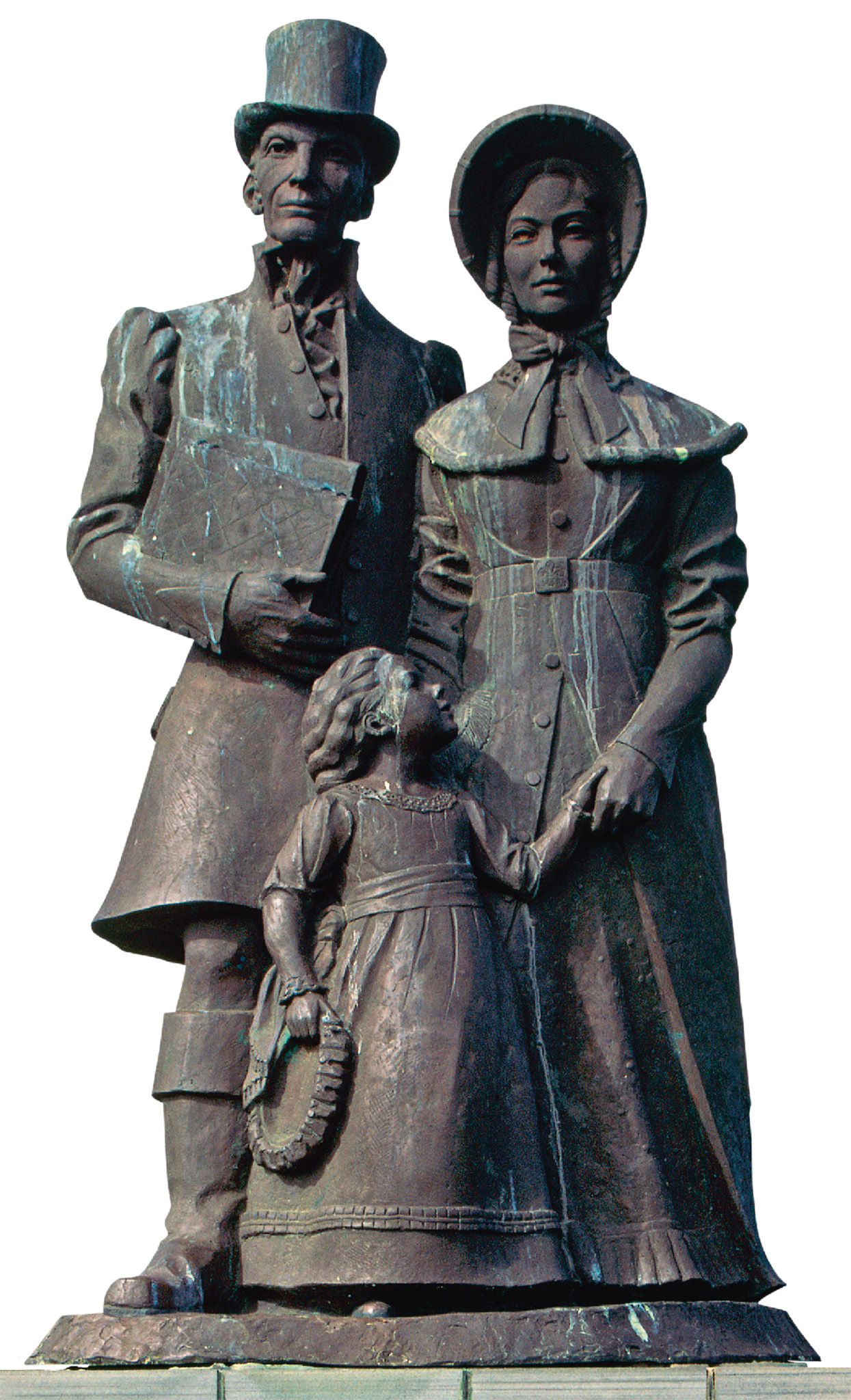
t Statue of a Victorian family, set in the grounds of the 1820 Settlers Monument
Founded in 1974 when the 1820 Settlers Monument officially opened, Grahamstown’s annual National Arts Festival (nationalartsfestival.co.za) is now the largest event of its type in Africa. Held annually in June/July, the festival runs for 11 days and comprises a curated main programme of 600 acts – including opera, stand-up comedy, cabaret and live music – as well as a Fringe programme that is open to all. Bed space is at a premium during the festival, so book your tickets and accommodation early.
EXPERIENCE Eastern Cape
|
stay The Cock House This 200-year-old guesthouse has a cosy ambience. There’s an elegant restaurant on-site, with a lovingly curated wine list. ⌂ 10 Market St, Grahamstown ∑ cockhouse.co.za Makana Resort Simple chalets and cottages, each with their own barbecue area. The accommodation is set within large central grounds that have a swimming pool and restaurant. ⌂ Grey St, Grahamstown ∑ makanaresort.co.za The Rat & Parrot This landmark student haunt offers regular live entertainment and a varied menu of comfort foods. Try the signature biltong, avocado and sour cream beef rump. ⌂ 59 New St, Grahamstown ∑ 046 622 5002 |

t Zebras drinking from a lake in the tranquil Mountain Zebra National Park
While the national park west of Cradock is the second-smallest in the country, its modest acreage in no way detracts from the visitor’s enjoyment. It was originally conceived as a sanctuary that was intended to rescue the Cape mountain zebra from imminent extinction. When the park was proclaimed in 1937, there were six zebras; by 1949 only two remained. Conservation efforts were successful, however, and the park now protects about 1,000 zebras.
The plains and mountains of this Karoo landscape also support a wide variety of other mammals, including cheetah, black wildebeest, kudu, eland, red hartebeest, springbok, buffalo, black rhino and caracal. More than 200 species of bird have been recorded here, including many raptors and the endangered blue crane.
The park’s rest camp, which overlooks a valley, consists of chalets, a campsite, a restaurant, shop and information centre. A short walk past the chalets leads to the swimming pool, which is set at the base of a granite ridge. Further into the park are a guesthouse and two mountain cottages.
For convenience, the park can be split into two sections. From the camp, a circular drive of 28 km (18 miles) explores the wooded Wilgeboom Valley, noted for its rugged granite land forms. The road passes the Doornhoek Cottage where the screen adaptation of Olive Schreiner’s The Story of an African Farm was filmed, and leads to a shady picnic site. The northern loop, which starts just before Wilgeboom, climbs steeply to the Rooiplaat Plateau and offers splendid views across the Karoo, where most of the park’s wildlife congregates. Early morning and late afternoon are the best times to visit the area.
EXPERIENCE Eastern Cape
|
stay Away with the Fairies This hugely popular backpackers’ retreat has a quirky Lord of the Rings theme and amazing forest views. There’s a campsite, plus a good mix of dorms and cottages. ⌂ Ambleside Close, Hogsback ∑ awaywiththefairies.co.za Die Tuishuise Choose from among this cluster of characterful 19th-century cottages, which have been immaculately restored for overnight visitors. ⌂ Market St, Cradock ∑ tuishuise.co.za Mountain Zebra National Park Rest Camp This beautifully sited rest camp is located deep in the heart of the park, and comes complete with a swimming pool. ⌂ Mountain Zebra National Park ∑ sanparks.org The Ibis Lounge A comfortable guesthouse with colour-themed rooms and an excellent on-site restaurant serving traditional South African fare. ⌂ Martin St, Nieu Bethesda ∑ theibislounge.co.za |
Did You Know?
Zebras are black with white stripes, rather than vice versa. Each individual’s stripes are unique.
The quiet village of Hogsback lies at an altitude of 1,200 m (4,000 ft) in the beautiful forested surroundings of the Amatola Mountains. Its name derives from one mountain peak that resembles the back of a hog when viewed from a particular angle.
The earliest known written reference to “Hogsback” was found in the journal of the painter Thomas Baines, who passed the “Hogs Back” while on his travels deeper inside South Africa in 1848. The Amatola Forest is often claimed as J R R Tolkien’s inspiration for The Lord of the Rings, in particular for his fictional forest of Mirkwood. Tolkien was born in South Africa in 1892, although his family relocated to England when he was a young boy.
The village is made up of a string of cottages, tea gardens, guesthouses and craft shops. It is well-known for its lovely English-style gardens of flowering plants such as rhododendrons and azaleas and its orchards full of soft fruits such as blackcurrants, blackberries and gooseberries. There are delicious jams for sale in Hogsback’s shops. Local hikes ranging from 30 minutes to two hours lead up to some pretty waterfalls in the forests.
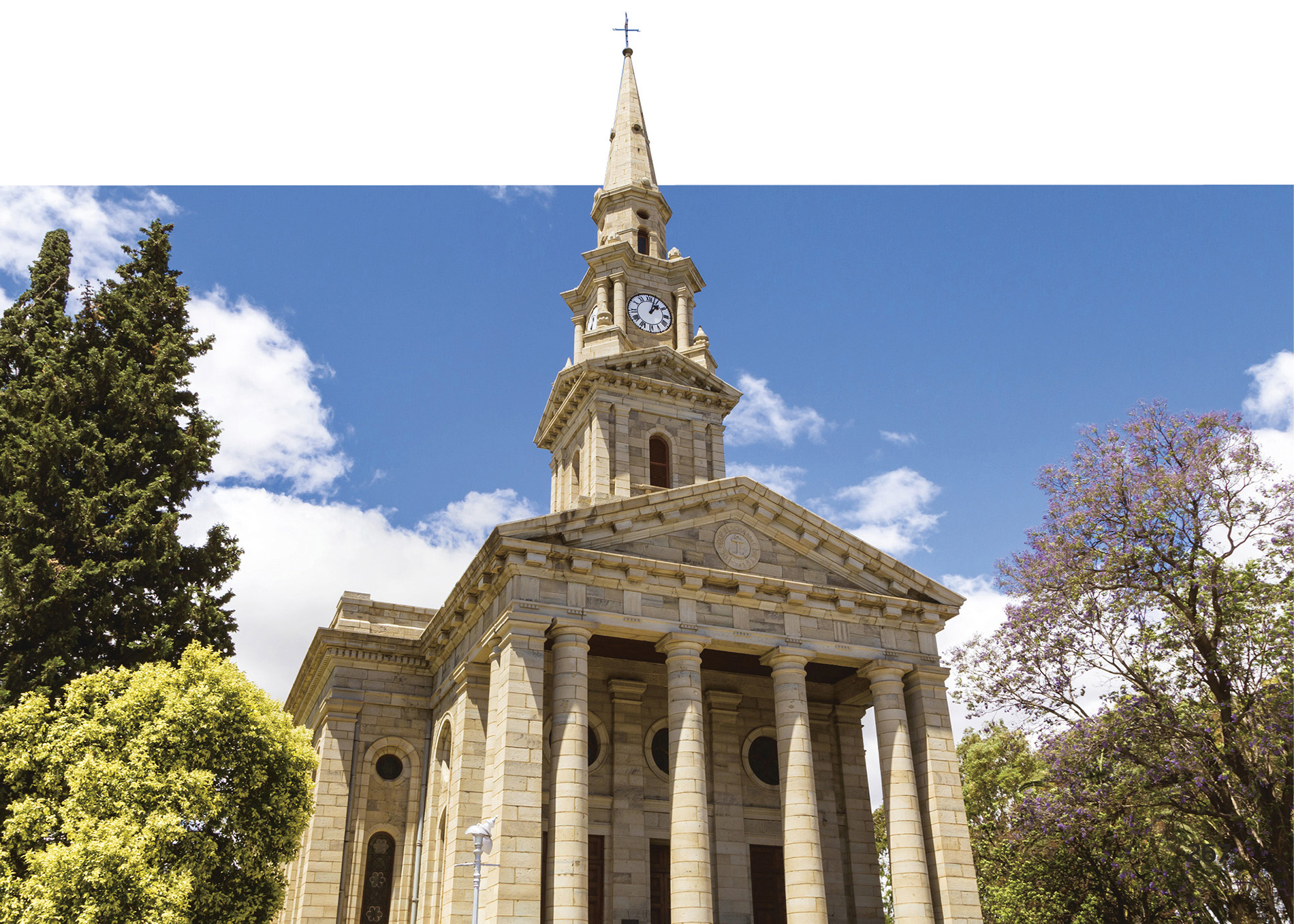
t The imposing façade of Cradock’s Dutch Reformed Church
In 1812, towards the end of the Fourth Frontier War, Sir John Cradock established two military outposts to secure the eastern border. One was at Grahamstown, the other at Cradock. Merino sheep flourished in this region, and Cradock soon developed into a sheep-farming centre.
The Dutch Reformed Church was inspired by London’s St Martin-in-the-Fields. Completed in 1867, it dominates the town’s central square. Behind the town hall, the Great Fish River Museum preserves the history of the early pioneers. In Market Street, Die Tuishuise is the result of an innovative project to restore a series of 30 mid-19th-century Karoo cottages and to create comfortable bed and breakfast accommodation for visitors to the town. Each cottage is furnished simply and charmingly in the style of the period, with meals taken in the adjoining Victoria Manor hotel.
EXPERIENCE Eastern Cape
Olive Emilie Schreiner

The Story of an African Farm is widely regarded as the first South African novel of note. Olive Schreiner wrote it while working as a governess on farms in the Cradock district. The book was released in 1883 under the male pseudonym Ralph Iron, and was an immediate success. Schreiner, a campaigner for women’s equality and a supporter of “Native” rights, wrote extensively on politics. She was buried just south of Cradock upon her death in 1920.
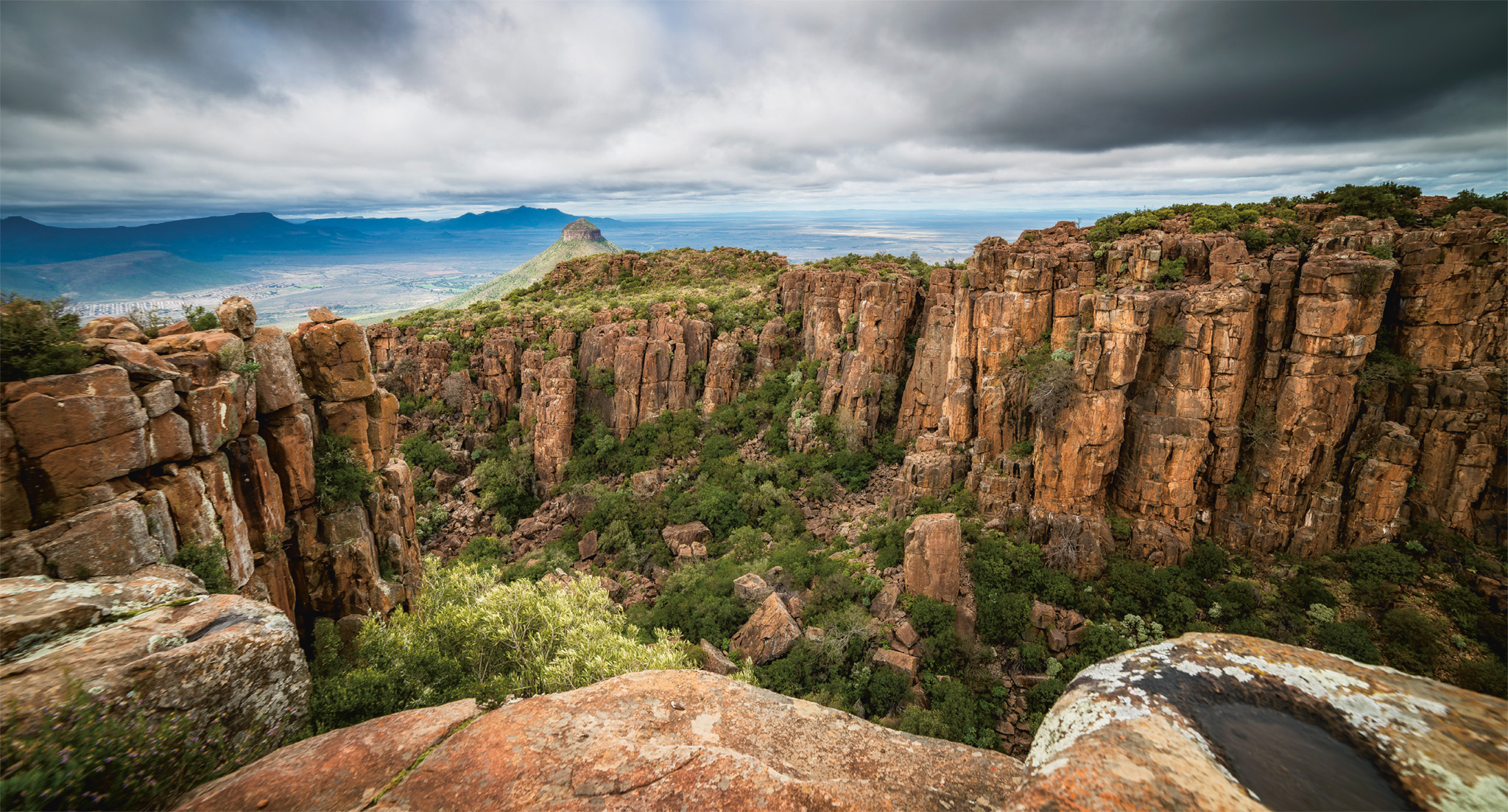
t The staggering scenery of Camdeboo National Park
In a bid to conserve typical Karoo landforms and wildlife, 145 sq km (56 sq miles) of land around Graaff-Reinet was set aside. West of the town is the Valley of Desolation, where spectacular columns of weathered dolerite tower 120 m (390 ft) over the valley floor. A 14-km (9-mile) road leads to a view site and a short walk, while the circular day hike is reached from the Berg-en-dal gate on the western edge of town. The eastern region of the nature reserve includes the Driekoppe peaks, which rise 600 m (1,950 ft) above the plains. This section sustains more than 250 species of bird. The populations of Cape mountain zebra, buffalo, red hartebeest, springbok, kudu and blesbok are expanding, and many may be seen. There are game-viewing roads and picnic sites situated around the Nqweba Dam in the centre of the reserve, and boating, canoeing, fishing and windsurfing are permitted.

t popular with hikers

Picture Perfect
Valley of Desolation
This other-worldly landscape of looming dolerite columns, located in Camdeboo National Park, is at its most beautiful and photogenic in the late afternoon – although it’s certainly worth staying on for sunset.
In 1779 Colonel Robert Gordon reached the banks of a watercourse that was known to the Khoina as Gariep, renaming it the Orange River, in honour of the Dutch Prince of Orange. In 1928, Dr A D Lewis advanced the idea of building a tunnel linking the Orange River to the Eastern Cape, but work did not begin until 1966. In September 1970 the last gap in the wall was closed.
The Orange River is South Africa’s longest river, and the Gariep forms the country’s largest body of water. The dam wall rises 90 m (297 ft) above its foundations and has a crest length of 948 m (3,110 ft). At full supply level it covers an area of 374 sq km (144 sq miles). A corridor of bushveld surrounds the Gariep Dam, and is home to a few springbok, black wildebeest and blesbok. Gariep, A Forever Resort is situated at the dam wall, and offers comfortable chalets, a campsite and a range of activities such as fishing and boating. There are also tours of the dam wall. Day visitors must call ahead.
"
Gariep, A Forever Resort
⌂ Gariep Dam ∑ forevergariep.co.za
The turn-off to this village lies on the N9, 27 km (17 miles) north of Graaff-Reinet. From there, a good-quality dirt road traverses the Voor Sneeuberg (“in front of snow mountain”) and leads to Nieu Bethesda.
At 2,502 m (8,131 ft), the Kompasberg (Compass Peak) is the highest point in the Sneeuberg range. It was named in 1778 when Cape Governor Baron van Plettenberg visited the mountain and noted that the surrounding countryside could be surveyed from all angles from its summit.
Nieu Bethesda was founded by Reverend Charles Murray, minister of Graaff-Reinet’s Dutch Reformed Church. The fertile valley in the arid terrain reminded him of the Pool of Bethesda (John 5:2), and so he named the town after it.
In 1875 he acquired a farm in the valley and by 1905 the church (now in Parsonage Street) was completed. It cost £5,600 to build, but at the time of its consecration two-thirds of the amount was still outstanding. To raise funds, arable church land was divided into plots and sold at a public auction. The debt was finally settled in 1929.
Today, Martin Street, the quaint main road, is lined with pear trees and quince hedges. Pienaar Street crosses over the Gat River and passes an old water mill that was built in 1860. The first water wheel was made of wood, but it was later replaced with the existing steel wheel.
The peaceful village has attracted much artistic talent, including one of South Africa’s leading playwrights, Athol Fugard. This legacy is on display at The Owl House, one of South Africa’s top 50 heritage sites. Its garden is packed with an intriguing assembly of concrete statues: owls, people, sphinxes and religious symbols, created over more than 30 years by Helen Martins and her assistant, Koos Malgas. The walls, doors and ceilings of the house are decorated with finely ground coloured glass. Mirrors reflect the light from candles and lamps. Martin’s unusual work has been classified as “Outsider Art” (art that falls outside the artistic mainstream as a result of isolation or insanity) and “Naive” (an expression of innocence and fantasy).
"
The Owl House
⌂ Martin St # 9am–4:45pm daily ∑ theowlhouse.co.za

t Unusual sculptures found at the Owl House in Nieu Bethesda
Helen Martins
Born in Nieu Bethesda in 1897, Helen returned home to nurse her elderly father following two unsuccessful marriages. After his death, shy Martins retreated increasingly into her own fantasy world and began to populate her garden with surreal figures. In later years her eyesight began to fail and in 1976 she committed suicide. As an artist she remains an enigma.
